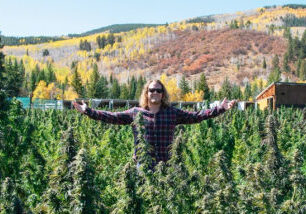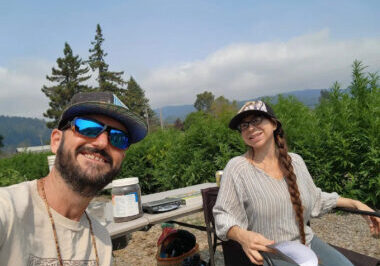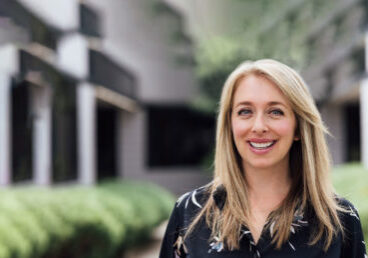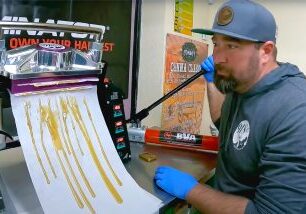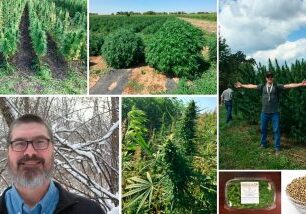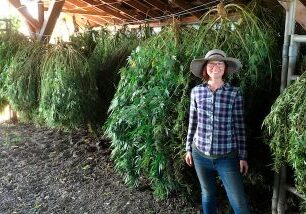In this episode we chat with Tom Forrest, Co-Founder of Indicated Technology out of Melbourne, Australia. In 2018 he was awarded the first-ever Churchill Fellowship award for cannabis agronomy. He traveled the world to learn about cannabis cultivation practices and the cannabis community as a whole.
Our hosts for this episode are Reed Preston, founder of Preston Hemp Co, and Dana Mosman, co-founder of Triminator.
Transcript
Intro: Welcome to Own Your Harvest, powered by Triminator, a global leader in Cannabis Harvesting Equipment. We will be bringing new, valuable insights from the front lines of the cannabis industry, giving direct access to our award-winning team and educating you on a variety of topics. From field service to extraction, we have lined up some amazing guests for 2021 to kick off this new podcast, and nowhere are your hosts Reed Preston, founder of Preston Hemp Co, and Triminator ambassador and Co-founder of Triminator Dana Mosman.
Reed Preston: Welcome to the Own your Harvest Podcast. This is the sixth episode of our podcast series. I’m Reed Preston, founder of Preston HECO and an ambassador for Triminator. I’ll be hosting this series along with our Triminator. Co-founder Dana Mosman. In this episode, we’re going to be chatting with Tom Forrest co-founder of Indicated Technology out of Melbourne Australia.
Dana Mosman: Thanks for the intro, Reed. Tom and I have had the pleasure of speaking several times and I know he’s got some great insights from the cannabis industry, for sure. In 2018, he was awarded the first-ever Churchill fellowship award for cannabis agronomy and he traveled the world to learn about cannabis cultivation practices and the cannabis community as a whole. So, pretty unique experiences, and I’m looking forward to hearing more about those.
Reed Preston: Yeah, most definitely. I actually just checked that video out on YouTube before, we got on here and it was really incredible, like such an amazing opportunity for you to get that grant and be able to travel the world and just, it’s like a dream man, you know, again, to go to all those facilities and chat with some legends in the industry. So, I’m excited to hear more about that from you on what it was like to travel, and for anyone that’s listening and wants to check out that video on YouTube, we’ll add it to the description of this podcast.
Dana Mosman: Perfect. Well, let’s jump into it, Tom. Thanks for taking the time this morning, I guess, Australia. Right? So, thanks for joining us.
Tom Forrest: Thank, thank you both very much for having me. It’s always a pleasure to chat and it’s nice that we can put these things together around the world and rely on technology to spread the good word about cannabis cultivation.
Dana Mosman: For sure. So, I mean, one of the things when we first started talking was you mentioned, I don’t know how it came up, but the Churchill fellowship trip. Tell us about out that how did you get into it? Like how’d you hear about it first and then tell us about kind of what you were trying to accomplish and your experience with it?
Tom Forrest: Yeah, so it was, it was quite almost a little bit serendipitous. My father’s
been involved in commercial agriculture my entire life, and he offhandedly suggested it in the full discussion, it was quite late into the evening and I had a bit of a cavalier approach to submitting an application, not really thinking that I had much of a chance to get it, and then I reached out to some good friends in the Australian Cannabis Industry to provide references. They called me through about a week and a half later and said, you’ve been invited to present at the next stage of interviews, and then there’s quite a regimen interview process where you meet with quite sophisticated people from all walks of life, a lot of conservative people in suits. Then you go up and you have to present this case to them as to why they should fund you to write a report that betters the Australian industry, and typically with a Winston Churchill Memorial Trust fellowship. The very social services-oriented, they look at how police officers could be more efficient or people in a courtroom, could be more relaxed and comfortable and I put my hand up and said, look, we have this new cannabis industry forming in Australia, we had a federal legalization regulation put in place in 2016, but we didn’t have any real experience in cannabis agronomy, particularly not in that pharmaceutical sector. So, to my surprise, I managed you get through all of the interview stages and they give you a phone call the night before, and then the following day it was published in a newspaper across Australia, which I think is a little bit quaint, still goes out in newspapers. Then the following year, you essentially get this ticket from the governor and the CEO of the Churchill trust saying, please let Tom into your facility and share your knowledge with him for the good of the Australian people in the Australian industry.
So, it’s a Willie Wonka golden ticket and I took that to the canopies and the auroras and around the world to eight different countries and more than 50 cultivation facilities and they let me into these facilities like at Aurora sites and let me film in the most majority of them, I did have some difficulties with some of the Israeli facilities there. Federal security requirements were, regimented to say the least, but it was incredible knowing and seeing the cannabis agronomy worldwide and what was happening there but also the culture behind it. So, with the guys from a greenhouse seed company, the strain hunters’ guys, we got to go and see Metallica play and hang out with them and then with a good friend of mine, cut in Myrie and Copenhagen, who runs a company called Fat Beans, he took us to meet Wu-tang Clan and we hung out with Wu-tang and enjoyed some particularly nice flowers and flavors backstage with Wu-tang, which its kind really opened my eyes that like these are childhood dreams and flowers.
Dana Mosman: That’s incredible. Yeah. Like I’m blown away about that grant, you know I wonder if there are any opportunities for something like that in the states. I know that agricultural grants can be fairly easy to come by if you’re set up specifically for the food industry or what have it, but if you’re producing, cannabis or cultivating cannabis or hamper, it can be extremely difficult to get like a grant from local governments to really follow your passion for cannabis and especially for someone that’s just trying to come up in the Cannabis Industry or Hemp Industry, it’s extremely difficult. So, hats off to you for getting that man.
Reed Preston: Tom, was that the first one like in terms of cannabis for, I mean, it sounds
like it, but first just straight up the first one?
Tom Forrest: Yeah. So, there has since been, a person looking at cannabis law reform, and then another person looking at Hemp Industry is a good friend of mine who has received a Churchill fellowship since, but up until that point, there’d never been any Churchill fellowship looking at cannabis agronomy. Since then, it’s been amazing to see, we have the Churchill fellowships and the Nuffield scholarships and Nuffield is a similar organization, but very agricultural focus and they’ve just announced another round of Nuffield scholars that are also going to be traveling the world, looking at cannabis Agronomy. So, I’m not claiming any credit for this, but it is that wave where it’s broken and now, we’re seeing more and more quiet traditional conservative, agricultural like pillars of the establishment, promoting the industry and allowing people to travel and have these experiences. So, it’s fantastic, it’s what we need that whole idea of, if we share knowledge, we grow together, where we don’t want to make the same of people that are pioneers in the cannabis industry worldwide have made and learned from. So, it’s an exciting time to be here in Australia and see these groups starting to get that traction.
Dana Mosman: For sure. What was the biggest sort of selling point, right? Like we always talk about people who are in cannabis, like, don’t understand why it’s just like, why everyone isn’t okay with cannabis. Right, and then people on the other side of the equation, I guess don’t see it the same way. Right. So, in terms of the Churchill kind of vetting committee, it sounds like you maybe had some folks on there who were open-minded from where they may be originated, you know, their viewpoints, but what was the biggest sort of selling point for you in terms of communicating the greater good through that process?
Tom Forrest: It’s a really good question because I know I’m walking into a room full of conservative minds. I’ve got dreadlocks and sleeve tattoos I’m putting myself in quite a challenging position there and so it was difficult, but it was also I guess the people that really need cannabis medicine the most are the elderly and the people that are starting to their health is waning a little bit. So, I think stressing the medicinal benefits and the evidence that’s starting to come to light of the medicinal properties of cannabis really started to shift the opinion and also stressed the fact that it’s an agricultural commodity. It’s a primary, it’s a multiple commodity crop, and we’re looking at not just cannabis of medicine, but the nutraceutical cosmetics, the food, and beverage grain, and even into the fiber sector of the hem side of things, I really want to hammer home that this isn’t a dangerous plant.
It is an agricultural commodity with a long history of use in mankind and so once they started wrapping their heads around that and focusing on the primary industry side of this, I think at that point, the penny started to drop that this was something that we needed to be aware of and not turning an ignorant blind eye to. So, it was quite
challenging, and I do remember on the final stage interview, I walked into a room and it was on the top floor of the Victorian children’s hospital and it was the biggest wooden table I’ve ever seen. It was just this enormous wooden table with about 30 people sitting around and they’re all very well dressed, and it was quite prim and proper, and there’s, it’s a fast-paced interview process, and they don’t pretend to be polite.
They really want to hammer you and fine holes in what you’re trying to do and I walked into this room, like Palm sweaty, quite nervous, and I see this lovely lady with purple hair and this other lovely lady with blue hair, and I just immediately went well, my hair is not the most spectacular in the room. Thank you, ladies, for taking that [inaudible 10:32], and I just really broke the, and all of a sudden, we realize that we’re not here to talk stereotypes or preconceived notions of what cannabis or the cannabis community is about, but we’re here to talk about something that’s quite a serious matter and has a benefit for the wider Australian community as an economic input, but also as a medicine. So yeah, it’s something quite proud of, and the church till trust did back me for a 10-week trip, but with a Willie Wonka golden ticket, it’s, it’s a once in a lifetime opportunity.
So, I literally put my life savings into that trip as well. I came home with about $112 to my name but I’ve traveled for about four and a half months and added in all these different stops along the way, and really, made that adventure something incredible by the end of it, I’d done close to a hundred flights in 2019. I was absolutely frazzled and you can see on the end of my Churchill fellowship, how frazzled I start to look in some of the footage from, [inaudible 11:33], I got home and did not travel too much and COVID hit and Melbourne lockdowns happen. So, be careful what you wish for.
Dana Mosman: I guess so. With medical and recreational cannabis, where is Australia at right now? Like, what are the laws and kind of regulations there in terms of growing consumption? All the above.
Tom Forrest: I guess like most countries in the world, we are still working on an evolving framework. We had the federal legalization of medicinal cannabis come in place in 2016. Politely it had some flaws as a framework, the office of drug control, wasn’t expecting the number of license applications they received. They put in place stringent regulations for security and fit and proper person and haven’t really been conducive to growth. It’s been quite a challenging industry for operators and startups in Australia to get involved in. So, right now it’s strictly a medicinal market, but, in the last sort of 12 to 18 months, we are starting to see more cannabis clinics pop up. So, kind of probably similar to where the states were, maybe 10 to 15 years ago, were, or in certain states, where you could go in and a doctor for a fee would write you a prescription for medicinal cannabis flowers, and then you could go next door to a pharmacy or a clinic and collect those flowers.
And then, it started for really serious ailments, like spasmatic diseases, chronic pain, and things, and now it’s opened up to a kind of less serious ailments. So, people are able to get a script for anxiety or sleep or things that are would be yeah. Considered less serious and so there is the flower market, is that starting to go like increase month to month, and there is more of these cannabis clinics popping up everywhere, in New Zealand, they’re probably a couple of years behind, but they’ve put in place slightly more pragmatic regulations and people are able to start cultivating still with strict requirements and proof that they’re a legitimate business, and it’s not a risk of diversion, but a little bit more interaction between the medical cannabis agency, ministry of primary industries, ministry of health, and that kind of thing with the cultivators and the manufacturers there.
So, it’s progressing, and then interesting, we had this awesome politician. I’ll probably butcher his name, but Michael Edison Peterson came into Canberra where our nation’s capital is kind of similar to Washington DC. All our parliament houses are there and like most of the state, people live in that state of civil servants. They recently passed the state law, allowing home cultivation and consumption where you can grow two plants outdoors. You have to have a maximum of 150 grams wet weight and 50 grams dry, which I know you pretty much have to take to your plans for the hedge trimmer to keep them small enough to be past the regulations there. But it’s a step direction they’re allowed to grow and they’re allowed to consume, behind closed doors and so it’s always interesting, like Canberra, the nation’s capital was the place will where, crudely porn fireworks in cannabis always kind of got the green light and everywhere else in Australia, this wasn’t allowed. The fireworks have long gone, the porn industry in Canberra in a suburb called Fishwick still exists but the cannabis sort of went under the radar and now has just been brought back out. It’s, terrible to compare them, but it’s nice to see. There is a little bit of a progression in the state of Canberra, and now where we’re quietly hoping other states in Australia will follow suit and common sense will prevail because as a country, we are one of the highest consuming countries per cap in the world. I think we’re ranked in the top three or four. New Zealand is very close behind us as well. Australians may be by nature, maybe by a culture, love cannabis consumption, but we’ve got a thriving black market to satisfy that market demand and that’s, as you’re both very aware, it’s riddled with problems. So, yeah, we’re hoping that medical cannabis is a Trojan horse for a functioning adult-use regulatory framework. But when that will happen, anyone’s guess at this stage.
Dana Mosman: With the consumption per capita consumption high, as you mentioned,
does that mean public opinion is generally in favor of it, or it’s like consumption sort of like that everybody’s doing, but nobody’s like publicly supportive of where, where does it land?
Tom Forrest: I guess it’s an I run in pretty friendly circles. So, in my community, it’s very, like smiled upon, but I think, at risk of polarizing the audience a little bit, you’ve still got boomers out there that have been raised with generations of prohibition, dogma, and still have quite a conservative outlook on it. I think to an extent Australia is more open to cannabis than other places I’ve visited in the world, more or less there are some countries that are like, like Israel, for example, consumption is commonplace. Like people walk along the beach and will smoke a joint and walk past the policeman, and there’s no real fear there in Australia, it’s a little bit more, or not quite that friendly, but it’s quite accepted here. I think it just really depends on what social circles you run in and so, like, you don’t want to be a dick head in the street blowing smoke in a police officer’s face, but also, it’s, we’ve got such a culture of it and like I went to university, most of our politicians went to university and so they’re all pretty familiar with cannabis consumption.
Tom Forrest: Well, they probably didn’t inhale. That’s the thing.
Reed Preston: That’s a quick disclaimer right.
Dana Mosman: I mentioned earlier before we started recording here, I spent some time and that was in 2015. So, I guess just before medical was starting to open up and I definitely had some strolls through, the botanical gardens with some good friends out there and enjoyed a puff and didn’t really, you know it was weird for me coming from the states, being over there and consuming or whatever, but yeah, definitely a different vibe than growing up in California, with medical cannabis, you know? Yeah.
Tom Forrest: I think there’s a lot of Melbourne and a lot of Melbourne’s youth culture exists in like, we have beautiful Parklands, we have beautiful outdoor arenas and like incredible national and native scenery that we can enjoy and that’s sometimes complemented with good flowers. So, there is a nice culture of that and I think it’s a little bit unfair, but like places in the world where people are criminalized for this behavior, and you only have to be the unlucky one or part of a minority group in particular that minority groups worldwide are overrepresented in incarceration for cannabis crimes and that’s something we see in abundance in Australia and New Zealand, and it’s something that is a real problem and I didn’t want to, with my Churchill fellowship, I wanted it to be strictly agronomy, but after seeing what happens worldwide, I did put a little bit of an activist advocate hat on, because I think it’s inhumane the way that certain people are treated for cannabis crimes while other people can skate by and that’s something that I’ve been, you read in my fellowship report, there is an activist element to it about having certain for cannabis crimes and looking at people that are doing time for cannabis. While right now there are public companies listed on the stock exchange doing the exact same thing, even at a similar scale and they’re being celebrated and rewarded for it. So, it’s a little bit bittersweet and I think we’ve got a long way to go. New Zealand actually did put in place a referendum for a federal adult-use industry, and it had one of the most amazing regulations that I’ve seen. It took into account consumption, distribution, community harm, harm minimization, community use and influence, and even the potential of indigenous rights, and that referendum went through last year.
And unfortunately, it missed out on a yes, vote by around 40,000 votes over a population of 8 million, and that was heartbreaking to see because I think that regulation had the potential to allow a leap, a New Zealand adult-use market to leapfrog the world, and it came out later though, this little weird one that they say not to dope campaign, which was the big sort of advocate in the red corner was funded by the church of Scientology other extreme religious groups. So, to this day, I can’t figure out why they were involved, what their vested interest is in essence a community societal issue or a political issue. But they put a lot of money into continuing that prohibitionist Del in New Zealand. I’ve got to apologize quickly. I told at some point; my dog would interrupt me. it’s just I try to get a sentence out.
Dana Mosman: Nice.
Tom Forrest: Video on these podcasts’ guys. So, you can see the cute little puppies that have cameos.
Dana Mosman: We’ll have to like, get a photo, put it in with your photo, you and the dog. So, we know who is interviewed here.
Tom Forrest: He’s little and he’s kind of scruffy. He’s already tried to bury his bone under my hemp plants.
Dana Mosman: What is the, I mean, all that kind of cannabis culture, like, what’s unique
about kind of growing cannabis in Australia or the, from an agricultural perspective, what are the challenges that you see and how do you see it or what did you take from the sort of seeing all these very commercial, very large-scale facilities and bringing that back to like Australia where I imagine it’s either been kind of black market and that has certain sort of size constraints generally. What kind of, from an agricultural perspective, did you learn from your trip in terms of like how to scale up or do it correctly in Australia when the time comes for that?
Tom Forrest: Yeah, it’s a good question because it’s something that a lot of people have this idea that like, oh, cannabis grows like a weed and, and yes, it’s got incredible genetic plasticity that allows it to thrive across almost every latitude, but that doesn’t mean every location is ideal for cannabis agronomy. We’ve seen that in Australia already, people are setting up facilities in the tropics, and dehumidification requirements are terrible, which is for me not such a bad thing as part of my income comes from [Inaudible 23:28].
Dana Mosman: Do more of that. That’s great.
Tom Forrest: Yeah. I guess putting Australia on and New Zealand in the same breath on the map is we have these incredible agricultural industries. We rely on our food bowl, crop commodities, we export a significant volume. So, we have very skilled farmers, amazing amounts of infrastructure, our boilermakers, sparkiest carpenters, all those ancillary industries that are required for agronomy. They all exist and thrive in Australia and something that I think is it’s a little bit of my subjective opinion, but from what I’ve seen, places where you can grow good wine or good grades, tend to lend themselves to good cannabis agronomy as well. You’re getting that long daylight hour, ideally sort of really nice long summers and significant, sorry. Puppies are having a much to my hand again.
Dana Mosman: So, there are good grades grow good cannabis, and set out facilities there makes a lot of sense. In terms of the other part of your question about scaling, what I’ve seen around the world was people went too big, too fast. They didn’t look at the size of market demand. What the bottleneck would be in terms of consumer access, distribution points, retail points, and what the rest of the supply chain would need to look like. They just went, we’re going to build a million square foot Glasshouse. That’s going to us a bazillion, I think on paper that looked great to investors, but in practice, every facility I went to had very monumental crop losses, like they’d be saying, yeah, the film in room seven, eight, and three don’t look in room five don’t and that’s in part because they
scaled too quickly and also didn’t really nail their foundations at the start. So, figure out what their methodology would be, what their nursery stock would be, what their inputs and outputs are, and what their requirements are to cultivate successfully.
So, I guess it’s that whole thing of growing organically scale to the size of the market as it exists now and in the short term, figure out what your methodology would look like, what inputs you require to learn from other skill sets as well. I think, like with the old Juris bag, we had a lot of American master growers coming across and they didn’t know how to comply in a highly regulated pharmaceutical market and we’ve seen that problem worldwide. They’re still using, blah, blah, blah, bottled, nutrient, and not really understanding the foundations of why that using a particular bottle or a particular mineral, and what I’ve seen around the world are some of the best growers come from other commodities, like a good friend of mine wine who used to cultivate at med relief who now has his own consulting company in Canada.
He was in the max don’t chew the power cable, that’s not smart. So, one came from the cup flower industry growing Chris Anthems and the uniformity required for Chris Anthems Andia is very similar to the uniformity required for a successful medicinal cannabis facility, and his facility at Mele in Brampton was some of the best that I’ve seen. You can see photos on my Instagram account of uniformity, where a trellis nets, every single square of that trellis net has a matching Cola. It’s that level of uniformity that you need to, particularly in indoor cultivation, to maximize your footprint or maximize your efficiency in your footprint and groups like that, whether they’d taken these skill sets from cut flour and brought it into the cannabis space, I think really it showed how that can be a successful model. So, there are little insights.
I know these are things that I talk about in my fellowship reporters to no one has the secret source, no matter how much, some of the VPs of public companies in Canada preach about their secret source being the best everyone is still learning, and the cultivators that learn from one another and learn from other industries, they’re the ones that’ll mitigate those risks and grow more successful. So, there’s it’s a big rabbit hole to go down to what we can learn, but I think we need to approach it like an agricultural commodity where we share knowledge and we talk to one another and that’ll allow us to grow together and as a result, the industry will succeed more readily and without necessarily sugar-coating failures or trying to hide things behind closed doors.
Dana Mosman: You mean room, room five. Don’t go in there. Yeah, no, that’s good. Go ahead.
Reed Preston: I was going to say, I saw that firsthand here in Southern Oregon with the hemp industry when it was booming, and I’m sure you saw a lot of it too. Dana. I know we tend to chat about it a bit in 2019 and just everyone. Yeah. Just planting, throwing seeds out there and thinking they got million-dollar acres and then realizing, oh, they’ve got to cut and dry all this product somewhere and then not even thinking about processing it either, you know, bucking and trimming and the whole nine yards should kind of…
Dana Mosman: Or selling it.
Tom Forrest: Yeah. Selling it too. You think about selling it when there are hundreds of thousands of acres of it, you know, which went from whatever X amount, 10,000 acres to a hundred, 200 within a year? Yeah, but yeah, just sort of that. Yeah. Going too big too fast man, you sometimes, you know, the smaller and slower approaches, you learn a lot more from, and then you can scale off those. Right.
Dana Mosman: And start the business model with like $ 200-pound assumptions instead of like $1,600 outdoor assumptions or something like that. There’s a lot of those out there too.
Reed Preston: Some of the paperwork you see where people are doing their forecasting and they’re just putting the biggest yield with the biggest dollar value because that’s what they waiting for.
Dana Mosman: Yeah. Outdoor harvest size, indoor yield, and indoor prices.
Reed Preston: Exactly, I’m extremely pessimistic about running my numbers. So, sometimes I’ll be like, oh man, that’s pretty bad, but I’m really careful with what I predict. I never want to be let down and some years could be bad, man, you could have a really bad season, like some early rains here in Southern Oregon and just dealing with mold and a big loss. So, some of those things people forget that with growing outdoors, it’s no natural disasters could really ruin your whole crop.
Tom Forrest: And even growing indoors, like there are few people that have spaced out glasshouses and only really accounted for kind of ideal conditions, and now with more difficult weather conditions and climate extremes that we’re facing, there was a lot of glasshouses that were like hundreds of millions of dollars went into these facilities and they still the guys wanted better control of their environment, better control of their airflow and as a result, they had real challenges with their cultivation. So, I think it’s across the board people, kind of went really hard, really fast with what they were trying to do, what they were putting down on paper, without looking at exactly what’s necessary and kind of like plan for the worst and prepare for the best. Like it is still farming at the end of the day, they’re still growing a commodity that has inherent risks especially with cannabis genetics as they are at the moment, which is not like other agricultural or commodities with decades of refined scientific, like commercial quantitative tape trait has driven breeding, where a lot of the time breeding has been done as an art form and not a science and as a result, people playing with a cult that has the potential to be beautiful, but are like a dangerous mistress have the potential to go really, really quickly.
Dana Mosman: Yeah. And also like, they’re not generally like, well, they can be, but no one really knows, like they’re no one, well, historically we haven’t bred the plant for like agricultural scale. Right. So, like what works in an indoor garden or whatever is very different from an agricultural level of growth, I guess.
Tom Mosman: Well, yeah, definitely like traditional sort of traditional desirable, agricultural traits like pest and disease tolerance, drought tolerance, stress tolerance, and then looking into kind of leaf to stem ratios and real agricultural commercial trades, haven’t been a priority. Everyone’s been driven by a CFA, how high potency can we get? How good is the nose on a variety? And that’s important. Like we’re producing particularly in a pharmaceutical market. Like we’re driven by API by active pharmaceutical ingredient and potency is to an extent that the driver of price, but at the same time, if you can’t successfully achieve that potency in a risk-averse method, then there’s no point growing something that can hit percent. If it’s at the first sign of powder mild, you’re going to fall down.
Dana Mosman: Yep. No. on that note, I know you mentioned earlier, like guys from the states coming over and using bottled nudes, etcetera. Did I see that you guys, pure, was it pure that recently certified organic in New Zealand in Australia?
Tom Mosman: It’s so I’m super proud of, so our team over in New Zealand pure is my, it’s a farm project that I’ve been involved with for a few years now and kind of a little bit of
a passion project as well. It’s a team of really tenacious and intelligent Kiwis and we’ve put together, two farming sites and essentially a contract cultivators’ model that allows the industry to grow over in New Zealand, and one of the first things we decided was the farm site is a good friend of mine, it’s his family farm, it’s been in his family for over 140 years and we didn’t want to come at that with a traditional chemical agriculture approach. We wanted to do grow in a way that aligned with our values and so we, we set out to be organic, growing that sort of high tech, precision agriculture, utilizing AI weather stations and drones and all this cool progressive technology, but do it in a way was regenerative and sustainable.
And I know those two buzzwords are thrown around way too much, but we walk the talk, we got accreditation from Bio Growth. So, we’re the first company in Australia or New Zealand to under a federal license for Medicine Cannabis and be accredited by industry, and that’s no easy feed. They, go through a Q M S quality management system with a fine-tooth comb. They look at every input from source to finish and it has to fly, it has to be at above Bio Growth standard. Every input needs to be Bio Grow accredited. It’s quite difficult, but at the end of the day, it means we’re not paying for chelated mineral fertilizers. We’re just feeding our soil, stimulating our microbes, and relying on those microbes to allow our plants to grow, to their best profile. So, yeah, PIRO, we, we’re proud of what we’re doing over there. We’re, trying to pioneer the industry in New Zealand, and I think we’re doing a pretty good job in the industry and its infancy. We’re getting out of the gates in a strong way, and we’re doing it in a way that really yeah. Aligns with our values and so it suits us with people and the wider bureau team and family.
Dana Mosman: On the organic certification. How does that process work? Like, is it a national process, an international, like GMP, is sort of an international standard, right? How does the organic standard work?
Tom Forrest: Yeah, so bio is an independent body in New Zealand, it is recognized in other countries, but also takes into account other countries, organic requirements. So, sorry, max has just decided to climb onto the desk and it is one of the more regimented ones. So, there’s in Australia, you’ve got Australian organic, which is certain groups are able to get products into ACO with less stringent requirements than what bio growth requires. So, bio grow is well recognized and they work with the ministry for primary industries, and federal bodies to make sure it is at that the lead standard and it’s in a lot of countries around the world, people can make claims and use the word organic, incredibly frivolously and New Zealand is really clamping down on that as a country out in and around bio grow, making sure that people are using the term organic, held to that.
They’re not able to just throw it into a pitch deck without having some substance behind the claim. So, in Australia, we are seeing groups that are claiming organic, but they’re not, they’re just using, but it’s a bit frustrating to see, but I think by leading by example, showing it can be done, pure around 10 hectares this season, a little bit larger than what we did last season. So, we’ve got 60,000 seedlings on the go at the moment that is, they start in an organic seed raising mix, their non-treated seed there are no fungicides used and it’s a process to get seed that is certified, sea bra mix right through to our soil. AME it’s been difficult, but it does, it aligns with our values, it makes economic sense because our cost of the good soul will continue to decrease, and max is chewing on the power cable. Again, is not very smart.
Dana Mosman: It’s all good. Well, I think, we’re getting close to our 45-minute mark here, but we’ve got some questions or I think we got at least one question from our Instagram audience here and we just wanted to ask you that and let’s see, Dana, do you have that question there?
Reed Preston: What up, I mean, I think one of the questions I’ll just sort of summarize, people in the states are just generally interested in other markets, right? So, like in the US, we’ve seen, this progression from just a pure flower market to an extract market. So, what’s the market look like in your opinion, I guess being all medical, I don’t know how it sort of plays out, but where do you see the market going in Australia in terms of like extracts? Like what’s the interest in extracts in Australia versus flour?
Tom Forrest: Yeah, I think we’re still in a bit of a crude state at the moment. Not, not crude as in crude extract, but crude. So, I think, well, as we started with a huge influx of oils because that was the most acceptable for doctors to prescribe. Now we’re seeing demand for oils, not decrease, but Peter out a little bit, and the demand for flowers is just spiking significantly, but a lot of that is because of the products that are available. We don’t have that extensive range of everything from topicals to sublingual to soft gels, to all the different, to suppositories, not there’s a very small market, small number of products available to the market. I think as our regulations ease a little bit and we have just seen CBD in certain formats has been rescheduled. So, theoretically, it is available over the counter without a prescription, even though, so on caveats to that and there is a trend
towards making products more accessible and more available and as that happens and we simultaneously see more product formats become available, I think we’ll start to like, like in many things, we’ll follow the states in those market trends and novel delivery methods, vape cartridges, even I really believe that getting into an edible sort of the food and beverage industry, whether it’s as medicine or into an adult-use market that allows people that are quite unfamiliar with inhalable combustible formats. It allows them to dabble in cannabis medicines or cannabis consumption without needing to try something that’s completely novel to them. So, it’s a bit of crystal balling, but I really hope we start to see those new formats come to the market, and then the other side of it is the idea of cosmetics. I like you to see some of the crap written on like shampoo bottles in the super, and they, I don’t how they get away with some of the crap they put on that. But I think seeing different cannabinoids, like novel cannabinoids, I’m formally unappreciated cannabinoids, the viral CBG, all these different, cannabinoids that haven’t been really delved into, particularly not in Australia and the other flavonoids and terpenes that we can appreciate when that starts moving into cosmetics and nutraceutical markets. Then I think that’s going to be a pretty exciting time and we’ll see a pretty rapid uptake of novel product development, I hope.
Dana Mosman: So, you guys, I think you guys don’t have many, like concentrates out there then like Rosann or just any adaptable forms.
Tom Forrest: in the black market, it’s starting to make its way in Rosen, particularly in that sort of Instagram four 20 community you’re seeing, right. The hobby, like the cannabis community starting to embrace it and that, I think it’s quite cool that they’re in this underground way, progressing that side of things in the medical space, I think there are one or two hash-based or key-based products that are available through by prescription, which is quite funny when, when your GP calls you and he is like, look, I can get you green gelato flowers, or I can get you a bubble or thanks, doctor. You sound like a drug dealer it’s. Yeah. I think the, then on the dabs side of things and that extract side where we’re still in the dark ages where there are kids are figuring it out with a hair straightener and some baking paper, but commercially it’s, we’ve got a long way to go, and I hope that the medical cannabis companies who those with eyes towards more markets opening up in the future are looking at these noble delivery methods and extraction methods and solventless, organic extraction methods, these things that are a bit more environment, mentally friendly and create super yummy flavors. I think there’s definitely going to be something of interest there, but when that happens, I wish I knew.
Dana Mosman: Well, eventually it’ll happen and that’ll be a good day.
Reed Preston: Yeah. Then you guys can get some, TRP stacks over there for you Tom.
Tom Forrest: We’ll get that the Trojan horse has already made its way in, and now it’s just…
Dana Mosman: You’ll have to do another tour, just to do a solvent list maybe. Do the worldwide solvent list tour. You’ll have to sell that one a little differently. Maybe though.
Tom Forrest: Trust may take a shine to it. We’ll see how open-minded they’re they into and what’s a little bit different.
Dana Mosman: That’s right. Well, thanks so much for coming on Tom. Good to hear about the Australian market and the New Zealand market and all the stuff that’s going on there. So, if people want to reach out to you or see what you’re up to, what’s the best way for them to do that?
Tom Forrest: I guess, social media is always an easy channel. So, I’ve got on Instagram
@TomforrestCF, Churchill fellow or cannabis farmer, depends on who you ask, and on LinkedIn, you can find me, Tom Forrest. I’ve got a strangely large LinkedIn following, which is, I never thought I’d say, and on my website indicatedhyphentechnology.com and that’s where you can see the full range of products that we’re involved in distributing into Australia and New Zealand. The partners that we’re working with and a lot of links to what we’re doing here in Australia and New Zealand and where the industry is hopefully getting to with very cool and progressive agricultural technologies.
Dana Mosman: Perfect. Sweet. Yeah. Thank you very much, Tom, and thanks to everyone for the Own Your Harvest podcast, powered by Triminator. If you’ve enjoyed this podcast, please subscribe to the show and share it with your fellow growers and farmers. Have a good one, guys. Sweet. Let’s see.
